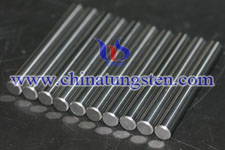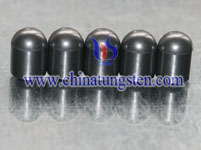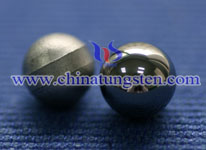
Properties Of Cemented Tungsten Carbide
Tungsten carbide properties of a particular "grade" of carbide are determined by its composition (its constituents and their relative amounts), the size distribution of the tungsten carbide grains after sintering, the binder metal type and content, the quality of the raw materials used, and the workmanship with which the material is made. Those most commonly measured to assess quality and define application areas are described below.
Cemented Tungsten Carbide Properties of Density
Density or specific gravity is the weight per unit volume of a cemented carbide measured in grams per cubic centimeter (g/cm3). It is essentially the weighted average of the densities of all of the components contained in the product and is therefore a check on its composition. For grades containing only tungsten carbide and a binder metal, the density of the composite decreases as the lighter binder metal content increases.
Cemented Tungsten Carbide Properties of Hardness
Hardness is the resistance of a cemented carbide to penetration by a diamond indented under a specific load. It is measured on the Rockwell A (Ra) scale in the US and on the Vickers (HV10 or HV30) scale in Europe and elsewhere. Hardness is primarily a function of composition and grain size with higher binder metal contents and coarser tungsten carbide grain sizes producing lower hardness values. Conversely, low binder contents and fine grain sizes produce high hardness values. Hardness is directly related to abrasive wear resistance.
Cemented Tungsten Carbide Properties of T.R.S.
Transverse Rupture Strength (TRS) is a measure of the tensile strength of a cemented carbide in a three point bending test performed on standard rectangular bars. It is reported in units of pounds or thousands of pounds per square inch, or in Newtons per square millimeter (N/mm2). TRS is perhaps the best measure of the relative utility of individual production batches since it surveys a reasonable volume of material and will detect low levels of critical internal defects. Products having relatively high TRS values are generally applied where shock, impact, or failure by breakage are factors.
 |
 |
 |
Cemented Tungsten Carbide Properties of Residual Porosity
Residual Porosity is determined by visually examining the polished surface of a sintered sample at 100X or 200X magnification. Ratings for "A" type porosity (pores less than 10 microns in diameter), "B" type porosity (pores larger than 10 microns in diameter), and "C" type porosity (carbon inclusions) are determined by comparing the size and frequencies of each pore type in the sample with those in standard photographs. Each standard photograph is associated with a numerical rating that is used to represent the porosity levels in the sample. In general, edge strength and toughness decrease as the level of residual porosity increases. At high levels of porosity, the wear resistance of the product may also be adversely affected.
Cemented Tungsten Carbide Properties of Magnetic Saturation
Magnetic Saturation is the degree to which the metal binder in a cemented carbide is saturated with carbon. It is most useful for materials having a cobalt binder. For a known cobalt content magnetic saturation values indicate how much carbon the cemented carbide contains – from unacceptably low values that indicate the presence of an undesirable carbon-deficient phase (known as eta phase) to unacceptably high values indicating the presence of free carbon (carbon "porosity") in the product. Magnetic saturation is sometimes used as an indicator of relative strength among lots of a specific grade.
Cemented Tungsten Carbide Properties of Coercive Force
Coercive Force is the strength of the magnetic field required to demagnetize a fully magnetized cemented carbide sample. Coercive force is typically measured in overstepped. The coercive force measurement depends on many factors including composition, sintered grain size distribution, residual porosity levels, and others. It is sometimes used as an alternative indication of hardness, but is best interpreted in combination with other properties as a measure of overall grade uniformity.
More Info>>
1.Tungsten Carbide
2.Tungsten carbide Bar
3.Tungsten carbide Rod
4.Tungsten Carbide Nozzle
5.Tungsten Carbide Button
6.Tungsten Carbide Inserts
CHINATUNGSTEN ONLINE is able to manufacture and supply tungsten carbide saw blade in different specifications. If you have interest in tungsten carbide saw blade, please do not hesitate to e-mail us by : sales@chinatungsten.com
Tungsten Information[Tungsten Information ][Tungsten Catalogs][Tungsten Dictionary]
[Tungsten News][Tungsten Videoes Bank][Tungsten Pictures' Bank][Tungsten Directory]
Chinatungsten Group[ChinaTungsten] [Tungsten Alloy Manufacturer] [Tungsten News] [Paper Weight] [Tungsten Copper] [Tungsten] [Molybdenum Products] [Tungsten Alloy]
[Tungsten Carbide Jewellery] [Tungsten Dart] [Dart Shop] [Tungsten Fishing Sinker] [Tungsten Powder] [Tungsten Metal] [Metals Price]
Address: 3F, No.25 WH Rd., Xiamen Software Park Ⅱ, FJ 361008,China
Phone:+86-592-5129696,+86-592-5129595; Email:sales@chinatungsten.com
Certified by MIIT:闽B2-20090025 闽ICP备05002525号-1
Copyright©1997 -
ChinaTungsten Online All Rights Reserved